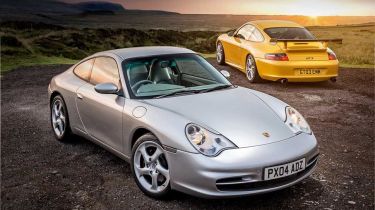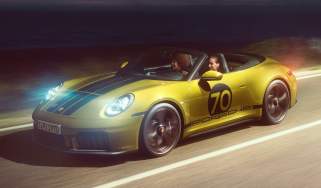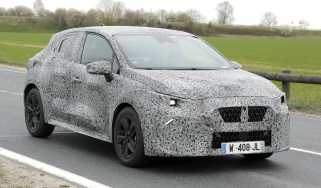Porsche 996 – is now the time to buy this bargain 911?
The last affordable 911 is the 996. But are you settling for second best? No way, says John Barker

Right now you can get a 911 for the price of a brand new, very nippy, small hatch. A flat-six-engined, 300bhp-plus, great-handling, loads-of-life-left, unfeasibly practical, bona fide Porsche 911 – for the cost of, say, a Vauxhall Corsa VXR. The catch? It’s the 996 model, the one lots of people ignore because it’s not a ‘proper’ 911; because it’s not air-cooled; because it shares too much with the Boxster including those funny headlights; or because it’s got an engine that will blow up.
Well, guess what. There is no catch. Googly headlamps apart, the Porsche 996 is a darned good 911.
Yes, there was some gnashing and wailing from hardcore 911 enthusiasts when 993 production ended in 1997, and with it both the air-cooled flat-six and the original, compact and near-sacred bodyshell, but truth was they were both past their sell-by dates. The 996 introduced a brand new water-cooled engine, with modern features such as four valves per cylinder and variable valve timing, and it made more power and torque from less capacity.
It was a bigger, roomier car than the 993 and, yes, it shared lots of parts with the Boxster – it was the same from the doors forward, essentially – but the bodyshell of the original 911 dated back to the early ’60s. The new, bigger body was 45% stiffer torsionally than the 993’s and weighed a substantial 50kg less, while under it was a development of the multi-link rear axle which had made the 993’s handling more predictable and exploitable than that of its predecessors. And the engine issues? We’ll clear that up in a bit.
Much to like, then, although what the 996 definitely did not have was as much character as the 993. It lacked that unmistakable air-cooled rasp and whirr, and the way you had to let the steering wheel do its own thing on bumpy roads and trust the car to go straight. But I’ve seen five generations come to market, from 964 to 991, and each has been criticised for being ‘not as characterful, not as engaging’ by press and fans. And then whatever generation it was would then go on to win every group test because, while it might not be as vocal or characterful or dangerous as the previous one, compared with its rivals the 911 was always the most compelling, character-rich car available.
So while a 996 might have seemed a bit pale after a 993, no-one getting out of a modern car and into a 996 today would complain that it was bland. It has taken Porsche the best part of 50 years to tame the rear-engine layout, and the 996 was a significant staging post on that journey. Most drivers will find enough classic 911 charm, foible and challenge here to warrant slipping from under a warm duvet early on a Sunday morning to go for a blast. This is a 177mph car that’ll get to 60mph in under five seconds and to 100mph in 11, and if you want to ramp up the excitement and engagement, there are plenty of specialists happy to oblige.
By the end of this year, the prices in this story will probably be out of date. Now is the time to act if you want to get a perfectly usable 911 for £16,000. Sure, there are mega-milers, scruffy ones and undesirable variants selling for less, but do your homework, buy the right model, buy the best you can afford and you won’t have any regrets. The 996 sold well, and there are still enough out there that you can afford to hold out for the right one. Or, at less risk, warranted, specialist-dealer cars start at around £20,000.
So, let us guide you through the issues, the models and the options, and take you through how a 996 should drive. For this we have a pair of 996s – a standard, late-model Carrera 2 plus a mildly-modified GT3 – and some tasty, testing roads up on the North Yorkshire moors.
We’ll start with the basics. The car you see here is a typical affordable 996 in what Porsche specialists will tell you (and the classifieds will confirm) is one of the most desirable specifications: a 3.6-litre 2004 Carrera 2 with the six-speed manual, in silver with a grey interior and 60,000 miles on the clock. So, how does it wear those miles and those 13 years?
From the outside, very well. It looks smooth and clean on its original Turbo-look five-spoke 18-inchers, the paint is in excellent condition, the panels are free of dings and scratches, and it’s on quality tyres with plenty of tread. The last is always a good sign; it’s said that if you want to know how clean the kitchens at a restaurant are, visit the toilets. I reckon an owner prepared to keep a car on good tyres probably won’t have skimped on maintenance.
‘Regular maintenance is a must,’ says Darren Anderson, boss of specialist RPM Technik. The company has been championing the 996 for a number of years now, sourced the Carrera 2 for this feature and even lent it to Octane in its raw, not-yet-prepared-for-sale state. So, do the engines blow up?
‘On a car we will be selling, the first thing we do is change the intermediate shaft bearing if it hasn’t already been done,’ he says. It might be fine, but Anderson’s view is that it’s simply not worth the risk.
This car is clean on the outside and very ‘slip-on shoes’ grey inside. The look of the interior is very similar to the Boxster’s, but with a more comprehensive cluster of five round dials featuring that reassuringly bold Porsche typeface and orange needles. It’s rather blandly styled, and a downside of the one-colour interior is that some surfaces are finished in soft-touch paint which is now feeling tacky to the fingers. Certain features date it: the four-CD stowage (there’s a six-disc stacker in the front boot, along with an upright space-saver spare), and a CD-based navigation system that hasn’t seen an update since the late 2000s. So it defaults to pointing in the general direction of the destination when it encounters a new road.
The fundamentals are great, though. The standard ‘tombstone’ seats offer both long-distance comfort and hard-cornering support, and the driving position is square, with seat, wheel and pedals all aligned. All-round visibility is excellent and it’s not a big car, just a few inches longer than a current Golf but narrower, so you’re at ease when positioning it.
The water-cooled flat-six was originally a 300bhp 3.4 but from the 2002 model year became a 320bhp 3.6. It has a melodic, pulsing character at idle, and on pulling away the whole car thrills gently to its distinct, guttural, flat-six drawl. I’d like more of this character in the mid-range, but recognise that when the engineers at Weissach were creating the 996 they had everyday use and cruising refinement in mind. A sports exhaust offered in period gave a welcome uplift, and nowadays there are plenty of aftermarket systems to unlock the voice within.
Unexpectedly, the steering of this example is quite slow and heavy. There’s a brand new pair of N-marked, Porsche-spec Michelin Pilot Sports on the front, which usually bring out any sharpness that’s on offer, but even once they’ve been scrubbed-in by coarse Yorkshire asphalt, the steering response of this Carrera 2 remains a little softer, slower and weightier than I recall, something that RPM will look at before it is put up for sale.
On these B-roads, transverse ridges and sharp bumps draw little reaction from the Carrera’s front wheels but bring a sharp report from the wider rear tyres, along with some twitter from the trim. Yet when you get to bury the throttle on the exit of an inviting corner, deploying all of the flat-six’s torque, there’s no slop, no shift of the tracking in response to the loading. The rear soaks up the road’s imperfections and drives the car cleanly and solidly out of the turn. It’s utterly marvellous.
It’s still a 911, still a tail-heavy, nose-light 911, but compared with the 993 the front of the 996 feels better planted. So you can lean on it sooner in a corner, get on the throttle earlier and exploit the heavy, traction-optimised rear to fire out of the corners.
The early 996s had no traction control unless fitted with the optional limited-slip rear differential, while later cars like this one were fitted with PSM (Porsche Stability Management). There’s never any sign of intervention in the dry, so you never worry about exploiting its natural grip. Within a few miles you’re in tune with the dynamics, flowing easily down the road, placing the car with accuracy, informed via the wheel and the seat, at one with the car. This 996 isn’t showroom fresh but the magic is there. It’s a beguiling, engaging car to exercise on a demanding road.
This 3.6-litre flat-six has a more generous spread of torque than the 3.4, so you don’t have to flirt with high revs as often. But if you’re used to modern, small-capacity light-pressure turbo engines, the full-throttle, low-rev response of even the 3.6 won’t wow you. It’s a pretty solid, even delivery, the engine really finding its voice beyond 5000rpm and the last rush to the 7000rpm redline coming on strong when you hold out for it, so it’s an engine that encourages exercise. There’s pleasure in the gearshift, too, the lever moving with a light, swift action and the shift responding well to correct revs-matching and a touch of heel-and-toe finesse.
The GT3 we’ve brought along takes everything you like about the Carrera 2 and cranks the dial up to ten. The intensity is worryingly addictive. Values of GT3s haven’t gone crazy like those of the GT3 RS and, in essence, it’s not as special as that car, lacking any of its lightweight bits. In fact it weighs more than the stock Carrera 2, being built on the Carrera 4 shell with a larger fuel tank and some strengthening. But that doesn’t stop it being a phenomenal drive.
This GT3 belongs to enthusiast Robert Lancaster-Gaye. It’s a working car, tuned for hillclimbing, and is non-standard in some respects. Surprisingly, that vast, exposed carbon rear wing was a standard factory option on the Clubsport-spec GT3, along with the roll-cage, seats, belts and extinguisher. Non-standard are the lowered KW suspension with extra camber, the Alcon front discs and harder pads, the exhaust from the manifolds back, and engine mapping that lifts power from the stock 381bhp (the earlier cars had 360) to a round 400bhp.
Drop into the tight embrace of the bucket seat, slam the door and there’s a hollow ring from the stripped-out cockpit, like the lid of a biscuit tin being flexed. Start up and there’s a fantastic amount of detail in the engine noise, its machinations unfiltered by rear seats. Although it shares its cubic capacity with the Carrera 2, the GT3’s engine is in fact based on the crankcase of the Le Mans-winning GT1 racer. It’s a wonderful, hardcore flat-six growl and the gearshift is similarly mechanical, with a delicious, snickety, short-throw action – the shifter cables are from the Cup car. The flywheel is single-mass and the clutch release bearing chatters at idle like it’s falling apart (it isn’t).
Despite all the changes, there’s still much of the familiar GT3 character here. For instance, the ride is resilient rather than tough, so it still has the standard GT3’s ability to feel supremely controlled yet absorb small bumps for an everyday, rounded finish. All you have to be wary of is speed humps, says Lancaster-Gaye. The payback for this tight control is the sense of connectedness that gives you confidence to press on, even on wet asphalt, despite tyres better suited to the dry. Tactility and feedback are key, and the steering’s direct feel and response let you know exactly where the limit of grip lies.
The rear is potentially more of an issue, as there’s no traction control and this flat-six punches harder from low revs. That’s because of the engine upgrade and the fitment of a lower final drive ratio which drops the top speed from 190 to 170mph – not an issue on hillclimb courses. And what an engine! The revcounter reads to 9000rpm, the limiter is at 8000rpm, and after a peppy enough start this yowling flat-six goes crazy from 6000rpm, the GT3 surging forward on an escalating wave of power until the limiter intervenes. The brakes are sensational too. Addictive barely covers it, and the standard GT3 is much the same. It may not be an RS but it’s still a very special experience. Rare, too – only 50 GT3s came to the UK.
Right now, the 996 is an under-appreciated and undervalued Porsche. It’s the 911 that, at this moment, strikes just the right balance between classic character and modern performance and features. It will start, it will stop in the wet, and it won’t try to spit you off in the corners if you take liberties or take your eye off the ball. It has enough creature comforts and enough life left in it that, if you really wanted to, you could use it as your only car.
If you’d love to own a 911, you’ll love a 996. Do your homework, buy well and you’ll bag a bargain. As for those googly eyes – you’ll just have to live with them.
Find a car with the experts






